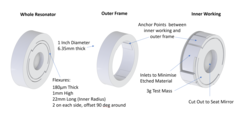Sensing the seismic
A new compact inertial sensor for a wide range of physics experiments
Seismic motion can significantly disturb precision measurements, such as those used in gravitational-wave detection and other fields. These experiments rely on control schemes that include inertial sensors to isolate them from seismic noise. Now, a team led by researchers at the Max Planck Institute for Gravitational Physics and at Leibniz University Hannover has developed a novel compact and high-precision inertial sensor with applications in a wide range of experiments. The sensor consists of a small mechanical oscillator with a remarkably high mechanical quality factor that fits on a one-inch diameter optic, and an optical resonator readout scheme. The sensor's performance is validated by a huddle test, which shows that its performance at frequencies below 20 Hz is comparable to the best commercially available sensors today, while being much smaller. At higher frequencies, it outperforms all other such sensors published to date. The sensor's small size and vacuum compatibility make it ideal for integration into seismic isolation systems. Its ability to operate in any orientation and to self-calibrate allows it to be used in a variety of future physics experiments.
Paper abstract
Compact, high-precision inertial sensors are needed in the control schemes of many modern physics experiments to isolate them from disturbances caused by seismic motion. We present an inertial sensor whose mechanical oscillator fits on a one-inch diameter optic. The oscillators achieve a mechanical Quality factor of a fundamental oscillation mode of 600,000 and a resonance frequency of 50 Hz, giving them a suspension thermal noise floor lower than all commercially available inertial sensors. The motion of this fundamental mode is suitable to encode inertial motion into the sensor readout. The oscillator is combined with an optical resonator readout scheme that achieves a displacement noise of 100 fm/√Hz above 0.2 Hz. We validate the sensors’ noise floor using a huddle test. Below 20 Hz, the sensor offers comparable performance to the best inertial sensors available today while being a fraction of the size. Above 20 Hz, the sensor is, to the author’s knowledge, the best demonstrated in the literature to date for such a sensor, with a self-noise floor of 0.1 ng/√Hz. The excellent performance of the sensors across seismically relevant frequencies, vacuum compatibility, and compact size make it a prime candidate for integration into sophisticated seismic isolation schemes, such as those used by gravitational wave detectors.













